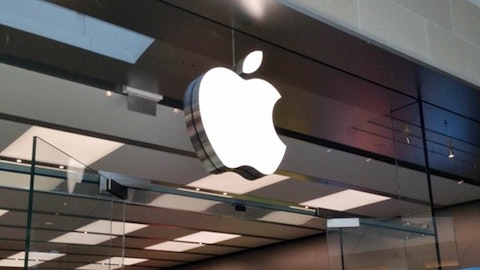And so far, we’re having great success. The sales conversations have been positive. The results client by client that we’re finding as we’re able to talk to them about the features and benefits of Visa Direct are great so far and feel really good about our results 6 months into this so far. So Chris, you want to hit the two pieces specifically?
Chris Suh: Yes, will do. So yes, on Reg II, so as we indicated, we did see some modest impact in the U.S. Payment volumes growth in the U.S. was down about 80 basis points from Q4 to Q1. And that slowdown was primarily due to a couple of things. One is the mix of spend days, but also there were a few smaller things, a softer October and the modest impact from Reg II that we’re talking about. So a couple of things. It’s important to note, we’ve actually not seen any meaningful changes to volumes being routed away since October. So all in all, the impact is modest, really hasn’t changed over the past quarter, and that’s actually what we have assumed and we shared for the rest of the year. Now to your second part of your question about one-time items, I talked a little bit about the things in the U.S., Reg II and the slow October.
The other place where I talked about onetime items was in the new flows business. As I said, the revenue growth was impacted by a couple of things. One, I talked about the cross-border normalization as on travel. And then secondly, there were these one-time items, and I’ll give you an example of one. In the normal course of our business, we regularly true up or true down our incentive and rebates with our clients based on their reported metrics. And in the first quarter, the net impact of these adjustments ended up being larger than we might typically see in a quarter. But all in all, it’s not something that gives us concern. The underlying business fundamentals remain healthy. It doesn’t change our expectations for full year growth for new flows revenue, which will continue to outpace consumer revenue.
Jennifer Como: Next question, Jordan.
Operator: Our next question comes from Sanjay Sakhrani with KBW. Your line is open.
Sanjay Sakhrani: Thanks, good evening. I guess just a question on the slower volumes year-to-date, on the severe weather. I’m just curious if there’s been any softness beyond that. And then maybe, do you expect that spending to sort of reaccelerate because the weather has gotten better? Or maybe you can just speak about that a little bit.
Chris Suh: Yes. Thanks, Sanjay. Yes, we did see that growth slowdown in the first week of January. And we’ve looked really closely at it, and it’s directly correlated to the extreme cold weather that’s hit in many parts of the U.S. I’ll give you a few examples. For anyone in Kansas City, they know this. We went from 45 degrees in the last week of December to negative 10 in the first few weeks of January. And so no one was out and about, and we saw growth in Kansas City go from mid-single digits growing to declining mid-single digits. To take another example, in San Diego, those that are lucky enough to be there, 60 degrees, and we’ve seen stable mid-single-digit volume growth into January. And maybe a third example that highlights the swings that we saw, in Dallas, it was nearly 60 in the first two weeks of January and then dropped to below 20 degrees in the third week, and we saw the exact same pattern following with our card-present volumes in that third week.
And so to the second part of your question, the good news is we’ve seen these type of weather-related patterns before. They tend to be short blips, and over the course of the quarter, tend to get smoothed back out.
Jennifer Como: Next question, Jordan.
Operator: Our next question comes from Ken Suchoski with Autonomous Research. Your line is open.
Ken Suchoski: Hi, good afternoon. Thanks for taking the question. I wanted to ask about the EPS growth outlook. It looks like you’re guiding to high-teens EPS growth in fiscal 2Q, which I think implies a mid-single-digit decline in the share count quarter-over-quarter. But I’m just trying to figure out why that doesn’t flow through to the full year EPS growth figure where you’re guiding it to low-teens growth. So if you can help us reconcile that, that would be great. Maybe there’s some tax, certain OpEx impacts in the back half of the year that we’re not accounting for.
Chris Suh: Yes. It is specific to Q2. I think I mentioned on the call, there were some tax matters that were resolved outside of the U.S. that brought our tax rate down in Q2 into the 16% range. That same matter also had some benefit that hit the NOI line, which also then helped the high-teens growth rate on EPS in Q2 specifically. For the full-year, it doesn’t change the tax rate. It doesn’t change our prior outlook for EPS growth.
Jennifer Como: Next question, Jordan.
Operator: Our next question comes from Harshita Rawat with Bernstein. Your line is open.
Harshita Rawat: Good afternoon. I want to follow-up on services. Given how increasingly important these are to your revenue growth, can you give us some insights, quantification on the composition of your value-added services, DPS, CyberSource, risk, et cetera? And maybe also expand about the growth drivers here with regards to attach rates, processing penetration, geo expansion. They’re growing almost 2 times faster than your card volumes’ overall services, so we are trying to just have a clear guidance here.
Ryan McInerney: Yes, thank you. As I was saying earlier, I think the strategy is really firing on all cylinders. Our execution is firing on all cylinders. The client demand remains strong. The TAMs are large, as you were saying. Last year, we generated about $7 billion in revenue in the value-added services business. I think we said in the quarter, it was a little more than $2 billion and up 20% in constant dollars. Those are great results. To get in a little bit into the details of your question, I mean, we run these businesses segment by segment. In issuing solutions, we’re having great success with our network products around the world. DPS continues to have great success with clients in the U.S. I mentioned in my prepared remarks that we had renewed with Bank of America.
That’s one of our, as you might expect, largest clients in DPS, a fantastic partner, as well as a number of the other value-added services I mentioned. In the acceptance solutions business, CyberSource continues to have great success around the world, both with their omnichannel services as well as some of the value-added services they have, like token management service and the like. Our disputes business beyond just what I mentioned earlier around ServiceNow is having great success. Verifi is really firing on all cylinders, especially as it expands outside the U.S. Our risk and identity solutions business is really proving to be very resilient and high growth, both our Advanced Authorization Platform, Visa Risk Manager, Visa Secure, all the various different products that we’ve been bringing to market.
And then our advisory services continue to do well. I mentioned in a few of the client wins in my prepared remarks, the success we’ve had with our managed services platforms where we’re embedding teams of Visa employees in our clients, working shoulder to shoulder with our client partners day in and day out, week in and week out, month in and month out, helping them drive their business forward. I mean, that drives revenue growth. That diversifies our revenue. But more importantly than any of that, that embeds us in the building with our clients, helping them grow their businesses, makes our core business even more sticky. So yes, it’s execution, it’s product pipeline, it’s delivery, and we feel really good about the results. Thanks for the question.





